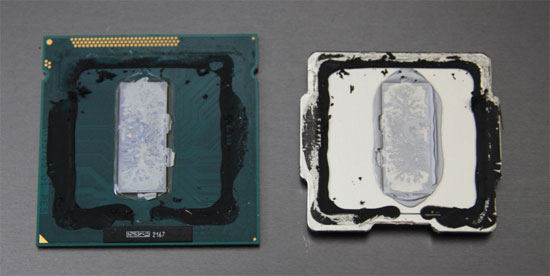Intel Core i7-3770K ‘Ivy Bridge’ Overclocked Benchmark & Temperature Performance
Ivy Bridge Overclocked and Tested Again

It wasn’t horribly long ago that breaking 4GHz with a CPU was left for those with ‘Extreme’ Cooling. In order to push past that 4GHz barrier you needed to run a CPU cooling solution that could bring your processor below the ambient temperature. Whether it was chilled water, Phase change cooling, or something much more extreme like dice (dry ice) or LN2 (liquid Nitrogen) would determine just how far you could push your processor. Unfortunately, cooling like that isn’t as readily available as a custom water cooling loop, or a top tier air cooler like the Corsair A70 cooler that I’ve been using on our motherboard testing over the past year or so. If you were running sub-ambient cooling you know the draw backs to it all to well. Dice and LN2 cant be used as a daily solution since you have to constantly refill the pot. Chilled water and phase change cooling both produce condensation on the motherboard and processor area and increase your chances of water shorting out your system. I’m not saying that it can’t be done, as many have done it, but these aren’t for the average overclocker.
Until recent years, when it comes to Intel processors, just about all of the overclocking was done with the Bclk. Unless of course you have deep pockets and wanted to spend a grand on an Intel Extreme processor that features an unlocked multiplier. If you did have an Intel Extreme processor you could increase the processor multiplier as well as the Bclk when overclocking. This combination of Bclk and multiplier overclocking allowed for great fine tuning when overclocking. Though not everyone has a grand to drop on the extreme processors. In May of 2010 Intel released their first mainstream processors with an unlocked multiplier! The Intel Core i7 875K and the Core i5 655K Lynnfield processors were the first K-series sku’s. Since then, the Intel K series sku’s have become a staple in the Intel product stack. If Intel ever eliminates the K-series processors they may just have a riot on their hands.
Moving past the LGA1156 Lynnfield processors, Intel launched the LGA1155 H2 socket along with their new ‘Sandy Bridge’ processors. This is where overclocking became both limited, and exhilarating at the same time! If you aren’t familiar with overclocking since the Intel ‘Sandy Bridge’ launch in January of 2011, it’s been a trip. Intel all but did away with Bclk overclocking. If you were lucky, you may have been able to find a ‘Sandy Bridge’ processor that was able to handle a 110MHz Bclk. That’s only 10% over the stock Bclk of 100MHz, more than likely you would have a chip that could handle around 105MHz Bclk. Fortunately Intel carried over the K-series sku’s and brought us processors with and unlocked multiplier! The Intel Core i7 2600k and the Intel Core i5 2500k had a maximum CPU multiplier of x59. What made overclocking with Intel ‘Sandy Bridge’ exhilarating was the frequencies we were able to hit! Our first run at Sandy Bridge overclocking we were able to hit 4.8GHz+ on air! Until this point that was absolutely unheard of! Overclocking with the Intel ‘Sandy Bridge’ platform was like a fine wine, it only got better with time! Not long after the initial launch ASUS introduced a feature inside their UEFI BIOS called Internal PLL Overvoltage. The Internal PLL Overvoltage allowed us to push the Sandy Bridge processors further yet.
Now we can jump forward to today. Recently Intel launched the Intel Z77 chipset and the latest and greatest mainstream processors, aka Intel ‘Ivy Bridge’. The Intel ‘Ivy Bridge’ processors like the Intel Core i7 3770k have a number of changes in the architecture that allow it to consume less power and run more efficient. For an in depth look at the architecture of the new Intel ‘Ivy Bridge’ Processors you can check out our full review here. We definitely noticed a couple of things during our testing that are worth mentioning again. The first and potentially most important to most, is that the Intel Core i7 3770K was consistently faster than the previous generation Intel Core i7 2700K. What’s significant about this is that both the 2700K and the 3770K come with an out of the box clock speed of 3.5GHz. Obviously Intel made some improvements to the architecture as well as shrinking the die size to 22nm. If we look back at the power consumption page of the article we can see that the power consumption of the Intel Core i7 3770K is lower than the previous generation when we compare these two processors with comparable clock speeds.
Although the Intel Core i7 3770K uses less power, some would consider that the 3770K has an issue with temperatures. Since the launch of the third generation Intel Core i7 ‘Ivy Bridge’ processors, it has been discovered that Intel opted to use a thermal paste to transfer heat to the integrated heat spreader. The previous generation Intel Core i7 ‘Sandy Bridge’ processors used a little bit different technique to transfer the heat. The ‘Sandy Bridge’ core and the heat spreader were soldered together which is a much more effective means to transfer the heat.

A Japanese tech site, Impress PC Watch pulled their processor apart, and above we can see the TIM used on the third generation Intel ‘Ivy Bridge’ processors. They have also replaced the Intel TIM with a couple others and had seen a dramatic result. At idle they didn’t see much in the way of improvement, under a full processor load though it was a different story. By replacing the TIM, the load temperatures dropped by 11 degrees Celsius at stock settings. They also ran the Intel Core i7 3770K at 4.6GHz and saw a drop of 20 degrees! It’s not clear why Intel choose to go this route, though it doesn’t look like it was the best choice for them. With my little rant being over, we can move on to the good stuff. We are going to take a look at how far we can push our Intel Core i7 3770K processor on air cooling today. We will be using a Corsair A70, which is no slouch when it comes to cooling to try and keep this beast cool under a heavy load!

Comments are closed.